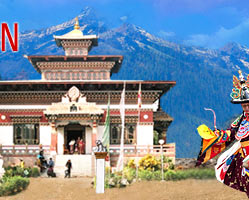The 'Dong Gyem Tsey' or Takin has been diligently chosen as the National Animal of Bhutan because it is unique, rare and native to Bhutan. It is closely associated to religious history and mythology of the country. It seems like an assembly of assorted animals and perhaps, this is the reason, that a strange story regarding its origins is popular in Bhutan. It is said that Lama Drukpa Kuenley, popularly known as the Divine Madman, went to Bhutan in the 15th century to attend a large congregation of devotees that had gathered from all over Bhutan to receive a blessing from another Saint. His unorthodox and outrageous ways soon made him unpopular with the group of the religious-minded people there and they started mocking him and provoking him to show his magical powers or a miracle.
Unperturbed by their reaction, Saint Kuenley demanded a whole cow and a goat for lunch. He relished the meat and devoured the entire animals, leaving only their bones. He then recklessly put the goat’s head with the cow’s bones and snapping fingers, commanded the beast to rise up and go and graze on the slopes of the mountain. The strange best immediately rose up from the dead and followed his instructions, leaving the people astonished and shocked. The animal was called ‘Dyiong-gyem tsi’ or takin. Takin looks like a cross between a gnu and a musk deer. It is a herbivorous animal and can be found in the north-western and far north-eastern Bhutan. Takin is considered to be quite vulnerable worldwide but survives well in Bhutan.
There are more than 1,000 takin flourishing in the Jigme Dorji National Park and other areas of Bhutan. They are bulky and large and yet can move very fast on the high ridges. Takin are sure-footed animals and can be easily spotted in Tsarijathang between Laya and Lingshi and in Tarina valley in Lunana in the summer months, when takins migrate to sub alpine forests and meadows above 3700 m to escape leeches, mosquitoes, horseflies and other parasites of the monsoon in the lower valleys. While most of the takins live at high altitudes, you can also see few of these animals in the ‘zoo’ on Sangaygang in Thimphu. They are also known as 'beestung moose' because of its humped nose and size that is similar to that of the North American moose. It has been classified as ‘Bu-dorcas taxicolor’ by taxonomists, a class solely for takin, since they couldn’t be related to other animals.
Takins mate in the summer and their gestation period lasts for 7 to 8 months. Usually, a single calf is born between December to February. The young ones are black while adults have golden yellow and brownish coat. Takins descend to the lower valleys around autumn season, in stages and grazing all the way. By late October, the temperate broadleaf forests between 2000 m and 3000 m turn into their winter grazing grounds. Since, they are the endangered species and the National Animal of Bhutan, law bans their hunting. Paching of the takin is not a common occurrence, as their body parts do not have high economic value. However, the traditional medicinal system of Bhutan believes that the horn of the takin, consumed in minute amounts, can help women during a difficult childbirth. The major threat to the takin is the competition for food with domestic yaks in the alpine regions and loss of habitat in the temperate regions.




